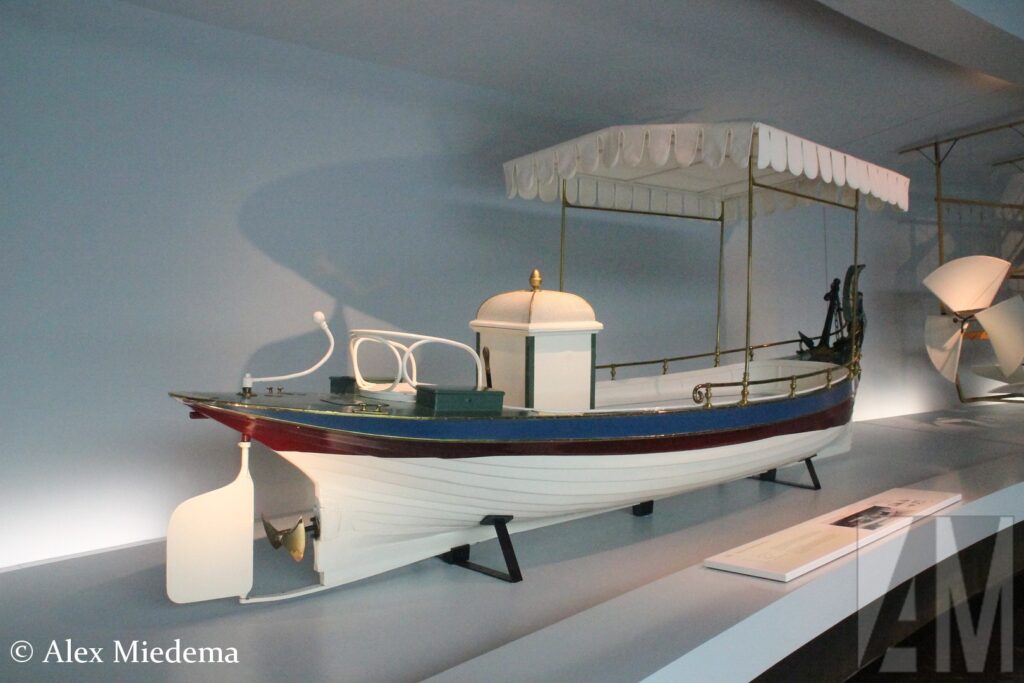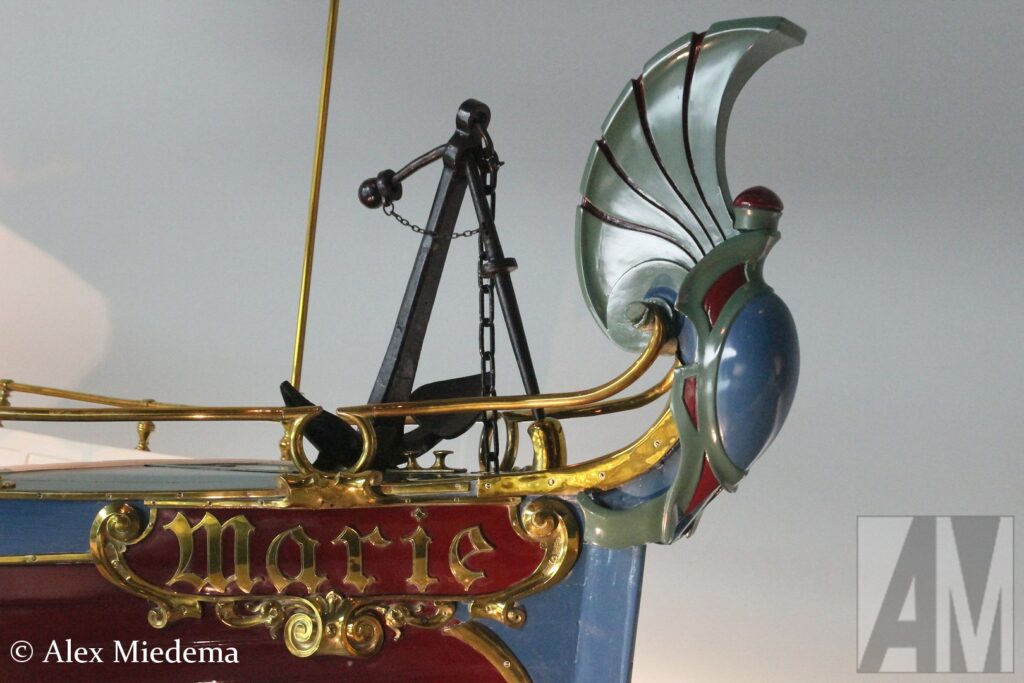“Close-up” – the name of this series from the Mercedes-Benz Museum says it all. Each instalment tells a surprising, exciting or behind-the-scenes story by shining a spotlight on details of a vehicle, an exhibit or an architectural or design feature. In the spotlight this time: the motorboat “Marie” from 1888 owned by Otto von Bismarck.

Daimler motorboat “Marie” from 1888
Luxurious: The small ship is made for an elegant summer cruise. The white-painted bench seat nestles in an elegant curve into the hull of the boat; above it a canopy supported by shiny brass rods for sun protection. Now all that is missing is a festively dressed party enjoying their ride across a glittering lake on the new watercraft. The passengers of the sleek motorboat with its red-white-and-blue hull and golden adornments were among the top of society at their time. After all, the owner of “Marie” was Otto von Bismarck, German Chancellor from 1871 to 1890. The boat was built 135 years ago by Gottlieb Daimler in Cannstatt. Today, it can be viewed at the Mercedes-Benz Museum, in Legend Room 1: Pioneers – The Invention of the Automobile.
A family matter: The name “Marie” is emblazoned in gold letters on a red background on the bow. Marie von Bismarck (1848 to 1926) was the first-born child of Otto von Bismarck (1815 to 1898). In 1888, the politician christened the boat in his daughter’s name and launched it on the lake of his country estate in Friedrichsruh, east of Hamburg. The fact that Bismarck appreciated the motorboat built for him in Cannstatt was a real coup for mobility pioneer Gottlieb Daimler. Because up to this point, his boats with combustion engine propulsion, despite their reliability and performance, were considered more of a technical gimmick and a curiosity than a modern watercraft.
Camouflaged prototype: Since 1882, Gottlieb Daimler had been working together with Wilhelm Maybach in Cannstatt on the high-speed internal combustion engine for mobility on land, water and in the air. In 1885, the drive system made its debut in the two-wheeled “Riding Car” (“Reitwagen”). As early as August 1886, Daimler equipped the first four-wheeled car in history with his engine. This date – and the patent application for the motor car by Carl Benz in Mannheim – make 1886 the birth year of the automobile. Also in August 1886, Daimler’s first motorboat, the “Neckar”, made its debut and was used for test runs on the river of the same name near Cannstatt. Allegedly, Daimler camouflaged the innovative drive system by covering the engine housing with insulators and wires, thus giving the impression that there was an electric motor in the fuselage. This would make the “Neckar” a real camouflaged prototype.

Secret: The innovation, which was still hidden at the time, is behind two doors made of white-painted sheet metal, which are located on the side of a slim, high box in the rear of the boat. Anyone who opens it discovers the pioneering drive system: it is Gottlieb Daimler’s single-cylinder engine, the “grandfather clock” (“Standuhr”). The power unit is completely enclosed by the filigree-looking housing. A dome of wire mesh arches at the top, on which a golden knob gleams. Only the handle for the throttle and the starter crank protrude discreetly from the bottom of the trim. From land, the small ship with an internal combustion engine would indeed have been visually almost indistinguishable from an electric boat.
Screw drive: A total of three boats were built in 1886 to test the combustion engine. The other two were called “Rems” and “Schwaben”. In size and equipment, the “Neckar” resembles the “Marie” built two years later. However, the Daimler boat of 1886 lacked the splendid ornamentation of its Bismarckian successor. What is the same, however, is the drive system: the engine acts on a shaft that drives the rigid propeller in the stern. It is steered with a rudder. Today, a boat of this size is usually propelled by an outboard motor.
Portfolio: The series production of motorboats began at Daimler in 1888. The hulls were supplied by shipyards and the engines were built in Cannstatt. The von Bismarck family’s “Marie” dates from this early period. Daimler no longer needed to hide its successful engine. Nevertheless, the machine remained hidden under its cover, just as the engine in the car later remained under the bonnet. This way, the boat passengers could enjoy their water party largely undisturbed by the working noises and the heat of the combustion engine.

Tradition: After the successful introduction of the single-cylinder engine as a boat drive, Daimler and Maybach consistently developed the application further. Daimler delivered the first four-cylinder engines as boat drives as early as 1890. Until well into the 20th century. Daimler, Daimler-Motoren-Gesellschaft and, from 1926, Daimler-Benz AG produced boat engines. Among other things, a dinghy of the imperial yacht “Hohenzollern” received a Daimler engine. In addition to high-performance marine diesels, high-speed drives were also produced for motorsport on water. In the 1950s, two record-breaking boats owned by former Daimler-Benz major shareholder Herbert Quandt were even equipped with the six-cylinder engine of the 300 SL sports car (W 198). Thus, the technology of the iconic “Gullwing” Coupé of 1954 and the eponymous Roadster of 1957 inspired highly ambitious water sports.

No Responses